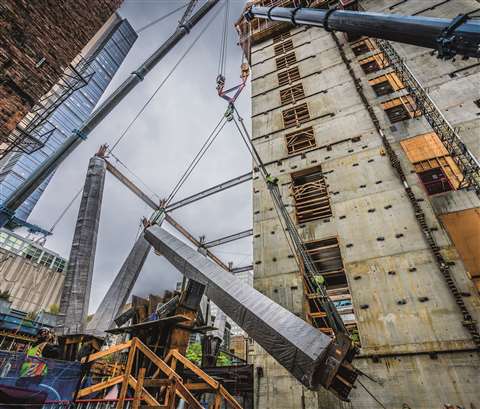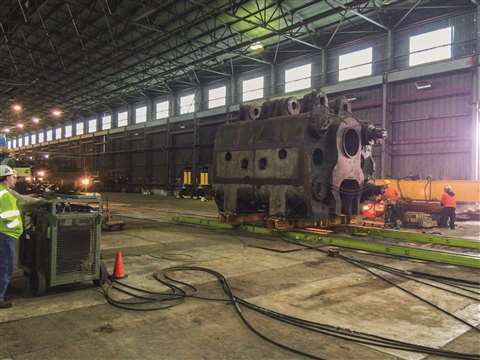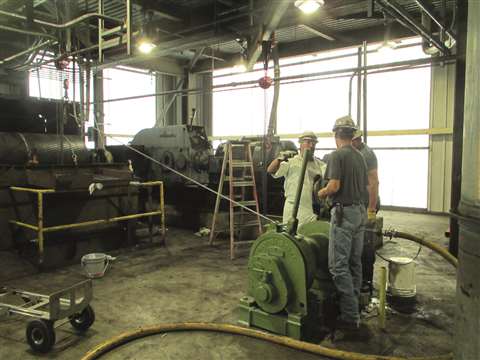How to choose the right rigging gear for your project
21 March 2022
Pat Clark discusses all the subtleties of job planning and renting rigging gear.
Renting rigging gear may seem like a very simple process, but there are many details to consider before cutting the purchase order. While in the bidding stage of a project, without the right equipment, you could get in over your head very quickly.
 If a project requires rigging that is larger capacity or more specialized, renting is a good option.
If a project requires rigging that is larger capacity or more specialized, renting is a good option.
Once the project is awarded, your team will want to come up with a safe and staunch plan for equipment usage. After you have agreed on a plan, where and how do you get the rigging gear required? During my tenure in this business, I have worked with countless customers – some who are confident they know what they need and merely request the bottomline price and those who want all the details of the entire process.
If you are unsuccessful in the bidding process, you will not need to rent any equipment for the job you lost. Think about this for a moment, as this is the first and possibly most important step when choosing to rent rigging equipment. Being realistic about what it takes to complete a project safely, efficiently and profitably can be tricky. If the project requires rigging that is larger than a capacity or quantity you own, renting is a good option. This allows companies to bid on projects that they otherwise would pass on due to the lack of capital outlay to buy equipment for this potentially one-off project. It’s important to think of this type of rental as your supplementary warehouse that has a large variety of tools and additional resources within your reach. Many companies have taken advantage of rental rigging as a way of expanding their business to new and different markets. It allows for geographic expansion and the ability to bid on more projects at once.
Equipment that was considered in the bidding stage may very well change once the lift plan is passed to the engineers or the field supervisory staff after the job is awarded. This is where the planning stage begins to ramp up and everyone becomes focused on the tasks at hand. In this case, that is what makes a great team – having multiple perspectives on the same lifting challenge.
 Rigging rental allows companies to bid on projects they might pass on otherwise due to the need to buy equipment for a potentially one-off project.
Rigging rental allows companies to bid on projects they might pass on otherwise due to the need to buy equipment for a potentially one-off project.
That stated, the costs of rental could be much lower or much higher than anticipated. We all make mistakes, but please do not make one where you believe all rental companies have the same equipment quality and follow the same industry standards. This is where you will have to do some homework. Consider this as an area not to pinch pennies to make up for dollars in the budget elsewhere. This is like the difference between a fast-food hamburger and one from an upscale steakhouse. One of these burgers will have a higher quality of meat, bun, lettuce, tomatoes and will be cooked to your standards. The latter will also cost ten times as much. But given the choice, which burger would you like to sink your teeth into?
Diligence required
Selecting a company that rents rigging gear – whether for hoisting, pushing/pulling, jacking, rigging, material handling or safety – there must be diligence assigned to this undertaking. There are several options at your disposal. Perhaps you have a fine relationship with the local fella down the street who may have one or two pieces of gear to bridge your deficiency.
You can scale companies of all sizes and capabilities, from the mom and pops and all the way up to some of the larger big box stores. I rent a commercial sewer rooter machine every 18 months or so from one of the big guys. However, every company will have its limitations on the breadth of their offerings. For example, a general rent store may have a wide variation of equipment (hence, the general) but may still not be a one-stop for all your needs. So, while an air compressor and powered fork truck may be on your list, you will be out of luck with a jack and slide-type system.
One of the most important factors is that you should be familiar with the equipment offerings, their applications and be very acquainted with your type of industry and common projects. Some companies may even offer services to review your plans to collaborate ideas. After all, being in your space, they have likely seen applications like this before and will have some insight.
Gold tips
Just as your company and business situations can change rapidly and unexpectedly, one of the most important things to understand is that rental inventories change hourly. You may be expecting to have a specified item on the truck out for delivery tomorrow only to be high stepped by someone who called in today to pick up the same item immediately. Rental companies know that jobs get delayed and pushed frequently and cannot afford to reserve a serialized item specific to that customer almost up until the order is about to be pulled for delivery.
There are two common solutions I have witnessed over the years: either the customer has a backup tool(s) that will act as a suitable substitute, or they should be prepared to pay rent for that item to be held. Many years ago, a competitor colleague of mine had a customer who was paying rent on equipment they would not be able to use for some time. Unfortunately, the vessel they needed to lift was being floated via barge but was stuck downstream because of ice buildup. The rental representative felt bad knowing his customer was paying for something he couldn’t use yet. The customer explained to him however, the lift was deemed complex, and the site owner required an engineer’s stamp on the lift plan drawings. In a sense, his customer was willing to pay for the right to have the equipment rather than send it back and take a chance it would not be there once the vessel arrived.
For any construction sector, especially cranes, rigging and specialized transportation, you should only work with rental outfits that follow American Society of Mechanical Engineers (ASME) B30 guidelines. Most of the rental companies on the market should be able to provide you with a certificate that acts as a proof of certification, testing or both. As you may know, ASME has been around for over 100 years. The volunteer members that sit on the various committees come from manufacturers, labor, end-users and, in many cases, are engineers. These folks are constantly updating the various volume guidelines to keep abreast of the latest technologies and many other construction industry changes. They make sure equipment manufactured has consistency and meets certain criteria, has detailed definitions and descriptions of equipment type, how to and how often the items will need to be recertified. The list is extensive.
 Just as your company and business situations can change rapidly and unexpectedly, one of the most important things to understand is that rental inventories change hourly.
Just as your company and business situations can change rapidly and unexpectedly, one of the most important things to understand is that rental inventories change hourly.
From the simple to the more complex and larger rental items, plan for how you unload the truck when the shipment arrives. Crane time can be very tight at times, so work with fellow contractors to be flexible when deliveries are scheduled. The supply chain is bad enough. It is important to ensure the rental company has accurate information to pass along to the logistics carrier. There have been stories of the wrong gate listed for a petroleum refinery, but with the correct address, but the driver left and the delivery needed to be rescheduled. This includes, but is not limited to, the main point of contact with a backup person with reachable phone numbers. Many rental companies have their own fleet and drivers, but some also use freight brokers to do the larger or geographically longer deliveries. While you may look to save some money on freight costs, beware – logistics, by its nature, can be a very deep rabbit hole. Beside the headaches of going solo, the rental company may be able to extend discounts for your delivery because they do so much volume with the broker themselves, resulting in a less costly delivery.
Re-rental considerations
The last factor to consider is re-rental. This is a common practice where an end-user customer wants only one invoice for all its rental needs. So whatever items the main rental company does not have, they re-rent from another company that does. The advantage is that you get all the items on one invoice. The major disadvantage is you will not have a resource if you have any questions about the re-rented equipment. This becomes critical to avoiding damage or even accidents from equipment the field staff may not be familiar with using or operating. Consider the balance between one invoice and being able to work directly with the owner of the rental items. They will know the equipment intimately, and perhaps offer field support, whether operationally or troubleshooting. In an industry where time is big money, having a direct pipeline to the equipment owner will help tremendously.
You may have learned there are a few more considerations that come with rental hoisting, pushing/pulling, jacking, rigging, material handling or safety equipment. From the moment your company receives the bid package to when you are tooling down the project, there is much to carefully weigh. You get what you pay for in this industry.
Recall the last time you lost a bid? You may have said the winning company is going to cut corners or just threw out a low-ball number to get is foot in the door. Believe me, rental rigging is exactly the same. Personally, I would not be looking to the lowest bidder on items that could be hoisting up 650,000 pounds.
Remember to value and patronize only companies that meet or exceed the ASME B30 guidelines. The cost saving benefit will never outweigh the cost of an incident. And if you are setting up delivery services on your own, take your time, ask the logistics company specific questions, like what does guaranteed delivery mean? And how do I track my shipment? These may seem like rudimentary questions, but you may be surprised with some of the answers you’ll receive back. And while re-rental has some downfalls, if not having a direct source to the equipment owner is acceptable, give it a shot. It may very well help with invoicing, tool tracking and other benefits.

A graduate of Northeastern Illinois University, Pat Clark is national rental support manager for LGH Americas, based in Bridgeview, IL. He holds certifications as a Master Rigger, Qualified Signal Person, Rigger Level 1 & II and Rigging Gear Inspector Level I and II.
STAY CONNECTED


Receive the information you need when you need it through our world-leading magazines, newsletters and daily briefings.



